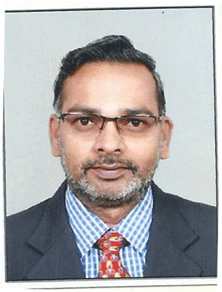Dr.S.Ganesan*
We all know the heterogeneity among the students in a class-room situation. Similarly the heterogeneity also exists among the teachers; due to which, the teaching process varies from teacher to teacher. It causes the change in quality of teaching-learning process in class rooms. If the same topic / subject are taught by different teachers, the quality (in methodology) ranges from ‘poor’ to ‘best’ teaching situation. The subjectivity in teaching cannot be removed easily. Through teaching aids, one can try to maintain same uniform standard in teaching process. For example, if we use power point presentation (PPT) slides, prepared by using MS-office package, the content coverage is maintained with consistence. The logically ordered sequential PPT slides enable us to provide almost uniform standard in teaching. At national level, with uniform high standard teaching is possible using same PPT slides, everywhere.
During mid-80s, in some part of Tamil Nadu, some of the tea stalls have upgraded to ‘Video Coffee Bar’. Those coffee bars were opened near college or school areas, to attract students. The tea or coffee was served in the hall during the video show itself. It was not exactly cinema theater model; but a dark hall with 20-25 seats capacity to watch short videos of 25-30 minutes only. They have used video cassettes players and normal TV of big size. The concept of ‘Video Coffee Bar’ could not continue for long period due to local administrative reasons; thus, they ended with short-life.
The recorded audio-class or video-class is also one such educational technology to deliver uniform standards. We all know the valid reasons for such uniformity or consistency. At the same time, we notice the inconsistence or non-uniform in ‘chalk and talk’ teaching method. Even same teacher teaching the same topic at second time or third time may not have uniform standard in teaching. That is due to the limitation of human behaviors in repetition, as it changes time-to-time; whereas, the educational technology and its gadgets facilitate the teacher to maintain almost uniform high standards.
Among the five sense organs, our eye contributes significantly high share in human learning process. Being so, we learn easily and quickly by watching video lectures. The Open and Distance Education universities such as Indira Gandhi National Open University (IGNOU) develops lot of Video CDs for its students purpose. The academic benefit out of such Video-Classes are significant for distance learners.
| Video – Class | Lecture Method |
| Consistence in educational standard, even repeated | Variation in the standards, if repeated |
| Powerful for teaching difficult concepts through mix of: animation, audio, video, ppt, text, colors, teachers etc. | Has some limitations |
| User friendly ( students are the end-users) | Teacher to student gap exists |
| Use of national level top resource persons, with rich experiences in academic research / achievements etc. is easily possible | Localized approach,
in most of the cases |
| One-to-One (or) One-To-Many is also possible
(for both individual learning as well as group learning situation) |
Normally for a small group of 30 or 60 students in a classroom |
IGNOU Port Blair Experience
The one year long experiments of conducting video-class on every Saturday at IGNOU Regional Centre, Port Blair shows us the positive results. Over 150 learners got benefit from 53-Saturday video class conducted using 65 CDs in a year. Although the response in terms of students attendance is thin; but a gradual increase in participation level is noticed week after week. Once a group of 10 students attended the video class and marked the peak attendance. The constant efforts of Regional Centre for communicating the details of Video-Class to students through SMS, Letter, E-mail, Phone Call etc. has shown good results. The regular support of print media in Port Blair, by publishing the press release of video class of IGNOU, is a big support to the student population of Andaman and Nicobar Islands. The video class on inverter supply, to meet the challenges of (expecting the unexpected) frequent power supply failure, is inevitable. The zero attendance on few occasions (especially in UG subjects) gives somewhat negative motivation to continue the video class. But, the regularity in organizing the video class has reached many learners. They have visited Regional Centre with confidence, to watch video CDs even during hot summer / heavy rainy seasons. The under-utilized CDs (by distance learners) has got effective role in video class and improved the situation to optimum utilization status. The academic benefits to students, who attended video class, is also reflected in improvement in passing percentage in semester / year end exams.
The Video Class is supplementary to Sunday face-to-face academic counseling sessions at learner support centers. The academic enrichment activity through video class is a new approach for distance learners of Port Blair region. Switching over to video class, from traditional face to face teaching-learning environment, is happening now in slow pace. In the days to come, all the computers at IGNOU Regional Centre will be showing videos for 10 to 12 different video classes running parallel (simultaneously) in every room of Regional Centre. Thus the magnitude of utility of video class will increase many fold. One day, all the available (in few thousands now) Audio-Video CDs of IGNOU will be exhausted and students will start demanding more and more new VCDs for Video Classes. Let us imagine such good transition period to come soon at Andaman & Nicobar Islands, where the educational opportunities are less.
(The author is *Regional Director, IGNOU Regional Centre, Port Blair; can be reached at 8900936718 or rcportblair@ignou.ac.in)
